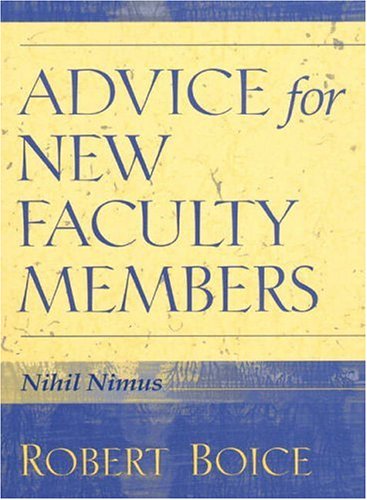I’ve been preparing a one-week summer workshop in humanities pedagogy for a few post-docs starting their positions this fall. My partner in this development is one of our Graduate Teaching Fellows, Jessica Riviere, who just dotted her i’s and crossed her t’s for graduating (or “walking”) in May. The confluence of these events brings me back to the early days of my career and what was most helpful in navigating my new role as a faculty member.

Immediately, Robert Boice’s Advice for New Faculty Members: Nihil Nimus (2000)came to mind. It was published two years after I actually began as assistant professor, but I was an early adopter of the now-classic guidebook. I hadn’t revisited it in years–until this last week’s thinking about these new post-docs and Jessica’s transition. I had forgotten that the book is divided into three sections that are all grounded in mindfulness–and one explicitly so:
- “Moderate Work at Teaching”
- “Write in Mindful Ways”
- “Socialize and Serve with Compassion”
His detailed table of contents gives an effective overview of what each section looks like. He encourages a “nihil nimus” (nothing in excess) approach to the three components of faculty work, but significantly he starts with teaching:
“In my 20 years of observation, far and away the most suffering for new faculty occurred in relation to classroom teaching. Nothing else, not even writing for publication or coming to campus with few social supports, consumed nearly so much time and well-being. No other demand so effectively supplanted social life and professional productivity. And nothing else was so likely to get novices thinking about abandoning academic careers.” (12)
Despite this sobering beginning, the book outlines clear, simple rules* for balanced approaches to all aspects of our work:

- Wait.
- Begin early.
- Work in brief, regular sessions.
- Stop.
- Balance preliminaries with formal work.
- Moderate overattachment and overreaction
- Moderate negative thoughts.
- Moderate emotions.
- Let others do some of the work.
- Limit wasted effort.
In the middle section, he explicitly connects his advice about “exemplary styles of working” to mindfulness (112):
Seven Simple Practices of Mindfulness
- Awakeness and staying in the moment
- Clear seeing of what needs doing and can be done
- Calm efficiency in doing it, including timeliness
- Freedom from destructive emotions
- Connectedness and compassion with self and others
- Letting go
- Gentle self-discipline
I have to chuckle, right before I quietly thank Boice, because our work seems to be marked by more binges than balance: over-preparing for teaching, “binge-writing” (we’re clearly aware of this unhealthy approach, but we embrace the term with pride), and serving on too many committees. Even this summer workshop we’re planning is being described as “boot camp” or a “crash course” because Jessica and I are condensing what we’re designing as a year-long curriculum for everyone else into one week for the post-docs who are starting their positions in August. All the more reason to introduce Boice’s ideas to them.
So, despite–or perhaps because of–the exigencies of our lived experiences at work, it’s helpful to periodically revisit Boice’s advice and pull back. I’m going to set myself a periodic reminder in my e-calendar. I’m calling it “Nihil Nimus: Advice for Old Faculty Members.”
Practice
This week, let’s try one of Boice’s explanations for his first rule: wait. In this paragraph, he applies it to our teaching preparations, but you can also think of it as the first rule in preparing for writing, attending a meeting, or having a conversation.
“Exercise 1. Pause Before Writing or Talking, to Reflect. That is, WAIT! Actually pause for a moment, perhaps as long as two seconds. Be prepared to hold yourself back if you feel an urge to do something else more immediately comforting (e.g., ‘First I’ll make that phone call, and then I’ll settle down to this’). Then, use these brief pauses of slowing and calming to sketch ideas, diagrams–even to jot down a quote. As thoughts appear, even vaguely, talk them over with yourself. If you cannot think of anything, freewrite what you guess you might think, by writing whatever comes to mind and without stopping to correct or edit. Whatever else, write it down, at least in some kind of shorthand or diagram. And then imagine talking it aloud to your students and how they will react/interact. All this, believe it or not, can be done in a few minutes” (23).
In the next week, as you start to prepare for something, experiment with this practice. See if it brings a different timbre to your work, and let me know how it goes.
—
* Okay, the recommendations are simple; the execution is more complicated.
—



